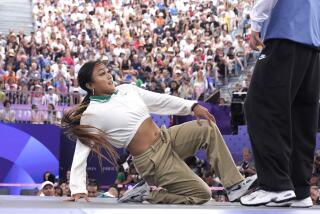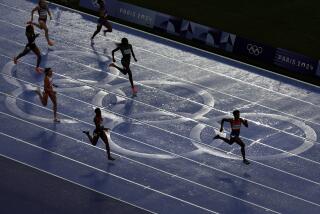IT’S WOMEN’S TIME TO SHINE
- Share via
She ran that first race for herself.
In the summer of 1972, Francie Larrieu Smith had all the opportunity she ever wanted spread out on the track before her as she toed the start line for the Olympic 1,500-meter heat in Munich, Germany.
She didn’t think about the sacrifices and she didn’t care--not at that moment, anyway--whether the Title IX legislation that had just sailed through Congress really would make it easier for women to follow in her footsteps. The last thing on the 19-year-old runner’s mind was being a pioneer.
“It just never occurred to me that I couldn’t do it,” she recalled.
That race launched a career that spanned five Olympics and landed Larrieu Smith at tiny Southwestern University in Georgetown, Texas, where she now coaches the men’s and women’s track and cross country teams.
“When I began running, we used to joke about it being the dark ages of athletics for women,” she said. “We were just ahead of the change. The girls I see running now can’t relate to that in any way. It’s pointless to even bring it up.
“Title IX? We’re now at the point where the mothers of these kids have had opportunities. But don’t get me wrong, more change needs to happen.”
Measuring change is always subjective, but the numbers provide a starting point. There were 96 women on the U.S. team in Larrieu Smith’s first Olympics and 203 on her last, when she walked into the stadium in Barcelona, Spain, in 1992 carrying the U.S. flag.
On Sept. 15, the woman who leads that contingent into the stadium in Sydney will have about 270 women marching behind her. They will test themselves in a record 120 events, against a record 4,100 women from around the globe, and the resulting dramas will be watched by more women than any athletic competition ever.
The biggest story could well belong to Marion Jones, on course to become the first female track and field star to win five Olympic gold medals. The most compelling story could belong to a woman, too, as Marla Runyan competes as the first legally blind athlete to make a U.S. team.
Not only will she run the same 1,500-meter race that Larrieu Smith did 28 years earlier, Runyan probably will also be entrusted with the U.S. flag. And like Larrieu Smith, she will be running the race for herself.
“I want my performances on the track to be seen for what they are,” Runyan said. “I don’t want it to be seen as an incredible effort despite being legally blind. I want it to be seen as an incredible effort, period.”
Yet numbers and the accomplishments of a few extraordinary individuals don’t tell the entire story of the growing influence and independence of women in sport at the turn of the century. There are pictures, too.
In Sports Illustrated, Jenny Thompson posed wearing nothing but her gold medals and a swimsuit bottom, her hands strategically covering her breasts. In the men’s magazine Maxim, another dozen female U.S. athletes appear in provocative poses and outfits.
While some feminists fumed over the photos, others held them up as proof of how self-assured women have become.
“Models and movie stars just don’t look like normal women,” pole vaulter Mary Sauer said, “so it’s great we’re being recognized for something other than being 6 feet tall and ultra-waif thin.”
Female athletes are not just comfortable with their bodies, they are adapting them to contests of strength, skill and endurance that not long ago were the exclusive province of men.
Beyond the traditional women’s sports of track, swimming and gymnastics, there is still plenty of room for grace. The U.S. women’s basketball team, for instance, a heavy favorite to repeat its gold medal-winning performance in Atlanta, will be led again by rail-thin, 6-foot-5 Lisa Leslie. But it’s at the other end of that spectrum, where power becomes as important as finesse, that the changing shape of the U.S. squad will be most apparent.
With the International Olympic Committee delivering on its promise to help unlock the potential of female athletes everywhere, women will compete for the first time at the Olympics in the hammer throw, pole vault, triathlon, modern pentathlon, tae kwon do, water polo and weightlifting.
To meet the challenges presented by such traditionally male events, the U.S. women have bulked up. The most obvious example is 17-year-old Cheryl Haworth, who at 5-9 and 308 pounds is not just imposing, but a real gold-medal prospect in weightlifting. The same is true of hammer thrower Dawn Ellerbe, who is 6-2 and 240 pounds and already a five-time U.S. national champion.
There are also athletic hybrids. Pole vaulter Stacy Dragila is only 5-7 and 140 pounds, but don’t be fooled. She was a rodeo rider in high school and recruited for college as a heptathlete, an explosive mixture of grace and power.
Any number of the athletes in those emerging sports tell stories to which Larrieu Smith and the women who went before her can easily relate.
For every Marion Jones, backed by considerable money and marketing muscle, there is a Maureen O’Toole, who at 39 scrimped and saved and came out of retirement for one final chance to display her brilliant water polo skills on the grandest of international stages.
For all the success and endorsements thrown at the feet of the U.S. women’s soccer team, there are still tales of too few dollars, inadequate coaching, crumbling facilities and crummy motels.
Title IX, which requires any school receiving federal funds to spend the same amount of money on men’s and women’s programs, has kicked open the doors of opportunity to two generations in an array of sports. But any woman who walks through them knows she will have to put the rest of her life on hold.
Thompson already owns five gold medals and a silver, but they all came in relays. For the chance at individual glory, she put off medical school at Stanford and returned to the pool faster than ever. Tara Nott wanted to be an Olympian so badly that after failing to qualify for both the U.S. gymnastics and soccer teams, she shifted her focus to weightlifting. After four years of working out for four hours a day, seven days a week, she got her wish.
“You sacrifice a lot to become good,” Nott said.
NBC is betting a huge amount of cash that stories like Nott’s will grab an audience estimated at 215 million. The network paid $3.5 billion to show the next five Olympics, and women will not only be the stars, they’ll make up most of the viewers.
“This is much more like the audience that watches ‘ER’ than a baseball game Saturday afternoon,” said David Neal, NBC’s Olympic coordinating producer. “The games are the only sports telecast in America with a higher percentage of women watching than men.
“So we know not to treat this like other huge sporting events. Even though we get big numbers, it’s nothing like broadcasting the Super Bowl 16 nights in a row.”
The percentage of women watching will be somewhere in the high 40s, with men in the high 30s and kids making up the rest, he said.
“It’s why we have to go out of our way to tell the athletes’ stories,” Neal added. “If viewers, especially women, care about an athlete, they will stay with us and learn what they have to about the sport.”
Anybody who makes the effort will be rewarded.
The girls of summer, the U.S. soccer team that won gold in Atlanta and the World Cup in 1999, returns better than ever. And unlike the ’96 Games, where they won in relative obscurity, every minute of every one of their games will be shown on the network or cable.
Mindful of the reaction after Brandi Chastain scored the winning goal against China last summer and stripped to her black sports bra, NBC won’t risk missing a minute.
The same is true for women’s softball. Last time around, the hero of the U.S. team was Dot Richardson, the infielder-orthopedist who collected a gold medal one day and reported for work in a Los Angeles County Hospital operating room the next. This time around, Richardson might see a lot less traffic on the basepaths. Star pitcher Lisa Fernandez heads to Sydney with a string of six no-hitters -- five of them perfect games--against topflight competition in the team’s exhibition series.
Some other high-profile U.S. teams figure to have it tougher. The gymnasts return only Amy Chow and Dominique Dawes from the Magnificent Seven--so dubbed when they became the first U.S. gold medal-winning team in Atlanta. But Bela Karolyi is back, lured out of retirement to revive a faltering program, and so, too, are the team’s chances to reach the podium.
“If,” said Karolyi, ever the taskmaster, “they perform to their potential.”
For the women, that’s what these games will be about.
When Baron Pierre de Coubertin revived the modern Olympics in 1896, he stipulated that women should not participate.
“It is indecent,” he said, “that the spectators of these games should be exposed to the risk of seeing the body of a woman smashed before their very eyes.”
Women will do a whole lot of smashing down in Sydney, but it will be stereotypes and barriers they leave in their wake.
More to Read
Go beyond the scoreboard
Get the latest on L.A.'s teams in the daily Sports Report newsletter.
You may occasionally receive promotional content from the Los Angeles Times.






